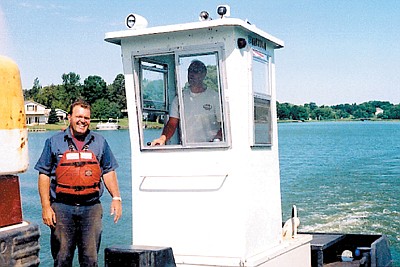July 31, 2003 at 2:46 p.m.
Area lake is first-ever worksite for countraption that looks odd, but works
Sure enough, as it plied the waters of North Center Lake last week, the 60-foot long floating shoreline restoration rig was a curious thing.
The barge is owned and operated by BVF out of Cambridge. It is one component of an armada of BVF heavy equipment and manpower that’s shaking out the traditional wrinkles of doing earthenwork within the shoreland.
Mike Mueller, the DNR Regional Hydrologist who regulates projects done within this region’s waters, told the Press BVF did check in with him while they were in the research and development stage for the barge. He said BVF is very good about complying with necessary DNR permits.
Mueller added, about the only negative thing with the rig is that he didn’t think of building it himself.
Eroding lakeshore can now be repaired or replaced without having heavy equipment ripping up lakeside lawns.
Problems with accessibility due to steep lakeshore or heavily wooded areas are no more.
Is your lakehome wedged in between the homes next door? No worries; this shoreline restoration crew comes in from the water.
Dead or storm-fallen trees and other debris like old boathouses, can be removed with a few scoops of the huge barge backhoe.
Dale Becklin and Bret Ninefeldt were calling the shots aboard the barge the day the Press rode along.
Becklin (pronounced beck-leen) has over 20 years experience in working around water. He’s a former barge man on the Mississippi and says he got bit by the lake bug working with David Vickaryous on Lake of the Woods.
Becklin was hauling materials to islands for recreational homes on Lake of the Woods, and he got to thinking if he could rig something smaller and lighter-weight for use inland, he might have himself an enterprise.
He credits Vickaryous as his “mentor.”
Designing this equipment meant arriving at the exact barge square footage required to displace enough water to carry the heavy loads in the roll-off. Yet, the barge couldn’t draw much more than a couple feet of water so it can be launched off regular boat landings when needed and get close into shore.
It also had to be maneuverable and reliable.
The men tried various power units, and settled on a 130 hp John Deere motor for the tow. An old splayed out Dumpster works well for containing dredging spoils, debris and delivering rip-rap.
Ninefeldt takes turns with Becklin piloting the barge, but this day he was mostly busy operating the skidsteer loader at the boat landing; offloading debris Becklin had lifted from a North Center shoreline.
Then, Ninefeldt loaded the emptied container with rip-rap (rocks). Driving his “Bobcat” up two metal ramps to the deck of the barge, he tipped the bucket into the Dumpster container, while the barge was bobbing in the water.
The whole operation has an aura of risky behavior. It’s compelling to watch.
Becklin and Ninefeldt know what each other is about to do, without communicating. In a sort of robotic choreography, Becklin would swivel the long arm of the backhoe so Ninefeldt could hook up the access ramps to lift and stow them. In leaving the shoreline project site, Becklin swung the backhoe arm to the shore and Ninefeldt leaped on for a lift back onto the barge.
You catch yourself thinking Becklin must be banned from those crane prize games at the fair, because he’s just so good at this. He effortlessly plunks that backhoe bucket inside a small area contained by the silt collection float.
Becklin’s cell phone rings often while he’s on the water.
He’s piloting the barge, but he’s also coordinating his arrival back at the boat launch for another load of rip rap, en route from a gravel pit about an hour’s drive away.
Two workers he left back at the North Center project site continue to arrange the rocks (big ones closer to the water) ... making sure the fabric erosion guard is in place and secured. He’ll have to remember to retrieve them.
“That’s the most important piece,” Becklin says of those final touches on shore with the rip-rap.
“Nobody sees all the stuff we do that leads up to the last half hour on the site-- that’s the point when (the customer) decides if it’s a good job or not.”
Becklin is one guy who loves his job.
He’s been on North Center Lake all week, and points out regular boaters, inner-tubers and anglers he’s gotten acquainted with working North Center.
He also shows concern for lakeshore that’s obviously failing, breaking off in big chunks into the lake and altering water quality.
Becklin appreciates North Center’s “lake structure,” which he describes as interesting because of islands, a variety of terrain and vegetation, and numerous ins-and-outs to explore.
He points to where people have left some aquatic vegetation growing and how that helps break the waves and lessen the water’s impact on shoreline.
Becklin says the people who have hired BVF care about preserving property value, sure, but they also care about the lake. Anyone considering restoration could estimate about $50 to $60 per linear foot, so the folks undertaking this work are biting off an expense.
This week Becklin had projects scheduled in South Center Lake.
He is guessing (this is the barge’s first year) that he’ll be able to work into October if the weather doesn’t get too inclement.
Then, the ice will come and the lake will rest.
Becklin will too; with plans to take his pleasure boat down the Mississippi River to Louisiana.





Comments:
Commenting has been disabled for this item.